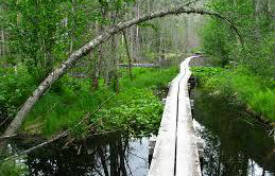Human activities have led to the development of urban heat islands (UHIs), where urban areas experience warmer temperatures than neighboring rural areas. According to the WHO, around half of the world’s population lives in urban areas, and it is expected that by 2030, 60% of the population will live in urban areas.  Many people may be affected by the negative impacts of UHIs which include: increased deaths from more extreme heat wave temperatures, increased cooling costs, and increased air pollution.
Many people may be affected by the negative impacts of UHIs which include: increased deaths from more extreme heat wave temperatures, increased cooling costs, and increased air pollution.
Construction of roads, buildings, and other structures replace the natural vegetated landscape, leading to changes within the local climate. These structures will absorb, store, and radiate more heat than natural areas. Buildings provide more area for absorption of solar rays than do flat surfaces, and they also decrease wind speed which allows air to stagnate and warm. In addition, concrete, asphalt, and steel are able to store more heat than trees, grass, and soil. Think about stepping barefoot onto grass or pavement during a hot summer day. The pavement will feel much warmer.
 And as a city is built up with dry, impervious surfaces such as asphalt and concrete, it replaces permeable, moist soils. These impervious surfaces create runoff from precipitation, instead of allowing precipitation to contribute to soil moisture. With this decrease in available moisture, less cooling through the evaporation process is able to occur. Man-made heat sources also contribute to UHIs through vehicle, industry, and cooling system emissions.
And as a city is built up with dry, impervious surfaces such as asphalt and concrete, it replaces permeable, moist soils. These impervious surfaces create runoff from precipitation, instead of allowing precipitation to contribute to soil moisture. With this decrease in available moisture, less cooling through the evaporation process is able to occur. Man-made heat sources also contribute to UHIs through vehicle, industry, and cooling system emissions.
Fortunately there are ways to combat the higher temperatures associated with cities. These strategies include green roofs, cool pavement, and parks. These strategies work by increasing moisture and thereby increasing evaporative cooling, and by reducing the absorption of heat.

 Click picture above to download your own Nature Prescription
Click picture above to download your own Nature Prescription






